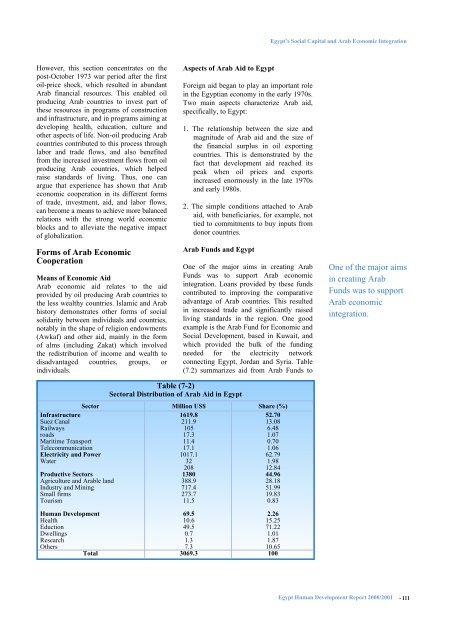English - Human Development Reports - United Nations ...
English - Human Development Reports - United Nations ...
English - Human Development Reports - United Nations ...
You also want an ePaper? Increase the reach of your titles
YUMPU automatically turns print PDFs into web optimized ePapers that Google loves.
Egypt’s Social Capital and Arab Economic IntegrationHowever, this section concentrates on thepost-October 1973 war period after the firstoil-price shock, which resulted in abundantArab financial resources. This enabled oilproducing Arab countries to invest part ofthese resources in programs of constructionand infrastructure, and in programs aiming atdeveloping health, education, culture andother aspects of life. Non-oil producing Arabcountries contributed to this process throughlabor and trade flows, and also benefitedfrom the increased investment flows from oilproducing Arab countries, which helpedraise standards of living. Thus, one canargue that experience has shown that Arabeconomic cooperation in its different formsof trade, investment, aid, and labor flows,can become a means to achieve more balancedrelations with the strong world economicblocks and to alleviate the negative impactof globalization.Forms of Arab EconomicCooperationMeans of Economic AidArab economic aid relates to the aidprovided by oil producing Arab countries tothe less wealthy countries. Islamic and Arabhistory demonstrates other forms of socialsolidarity between individuals and countries,notably in the shape of religion endowments(Awkaf) and other aid, mainly in the formof alms (including Zakat) which involvedthe redistribution of income and wealth todisadvantaged countries, groups, orindividuals.Aspects of Arab Aid to EgyptForeign aid began to play an important rolein the Egyptian economy in the early 1970s.Two main aspects characterize Arab aid,specifically, to Egypt:1. The relationship between the size andmagnitude of Arab aid and the size ofthe financial surplus in oil exportingcountries. This is demonstrated by thefact that development aid reached itspeak when oil prices and exportsincreased enormously in the late 1970sand early 1980s.2. The simple conditions attached to Arabaid, with beneficiaries, for example, nottied to commitments to buy inputs fromdonor countries.Arab Funds and EgyptOne of the major aims in creating ArabFunds was to support Arab economicintegration. Loans provided by these fundscontributed to improving the comparativeadvantage of Arab countries. This resultedin increased trade and significantly raisedliving standards in the region. One goodexample is the Arab Fund for Economic andSocial <strong>Development</strong>, based in Kuwait, andwhich provided the bulk of the fundingneeded for the electricity networkconnecting Egypt, Jordan and Syria. Table(7.2) summarizes aid from Arab Funds toOne of the major aimsin creating ArabFunds was to supportArab economicintegration.SectorInfrastructureSuez CanalRailwaysroadsMaritime TransportTelecommunicationElectricity and PowerWaterProductive SectorsAgriculture and Arable landIndustry and MiningSmall firmsTourismTable (7-2)Sectoral Distribution of Arab Aid in EgyptMillion US$1619.8211.910517.311.417.11017.1322081380388.9717.4273.711.5Share (%)52.7013.086.481.070.701.0662.791.9812.8444.9628.1851.9919.830.83<strong>Human</strong> <strong>Development</strong>HealthEductionDwellingsResearchOthersTotal69.510.649.50.71.37.33069.32.2615.2571.221.011.8710.65100Egypt <strong>Human</strong> <strong>Development</strong> Report 2000/2001 - 111
















